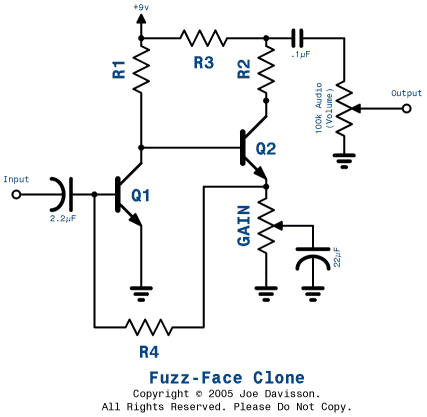Voltage Divider
Parallel Resistors
Resistor Codes
Linear Pot
Tapered Pot
Transistor Bias
Fuzz-Face
Trimpot Cheater
EMH is the Electronics Math Helper. It currently does only a few calculations, but more will be added as time allows.
Special thanks to Peter Snowberg for assisting with this project.

Calculates the output of a voltage divider.

Calculates resistors in parallel.






This helps you see a particular resistor's color code. 5% tolerance resistors are assumed. Values below one ohm don't yet work.

This provides a way to fake a custom linear pot with a one of a larger value. Values are in kiloOhms, so a 1M pot would be entered as 1000.
The resulting value can fluctuate as the knob is turned. This may be a problem in certain DC applications.

This provides a way to fake a custom tapered pot with a linear one of a larger value. Values are in kiloOhms, so a 1M pot would be entered as 1000.
The resulting value can fluctuate as the knob is turned. This may be a problem in certain DC applications.

This lets you plug in the bias values and see the effects. Resistor values are in kiloOhms! This is useful for finding bias values that are more tolerant to Hfe, resistor, or voltage variances.
Warning: Germanium calculations are probably not accurate, although it should get close. Some tweaking will be required.

Warning: This program is accurate for designing all-silicon Fuzz-Face clones. Germanium transistor calculations are available, but may not be accurate. Use this circuit at Geofex to get more accurate readings for germanium transistors, but beware that other factors can effect the outcome.
Update 5/26/05: Program now works mathematically instead of doing iterations to find appropriate values. Germanium/hybrid calculations should be more accurate now.
This calculator lets you plug in some values, and it will pick the right R1 to bias the circuit correctly. Use whatever resistor is closest to the computed value of R1. This allows you to quickly test parameters such as the gain control value and feedback bias resistor value R4.
After calculating, breadboard the circuit. Test to ensure the collector of Q2 is near 4.5v, especially when germaniums are involved. Adjust R1 slightly until it's right.
You need to know the Beta values for your transistors. Datasheet values won't do, so measure the values with a DMM that provides the function, or use the Geofex circuit to obtain the value. Q1's beta value needs to be especially accurate, as even a 20% difference can throw things off.
Calculates four series resistors to be used instead of a trimpot. (The unused resistors are
simply shorted across.) Sixteen levels of precision are available:
Code 1 2 3 4 ---- ------- 0 - - - - 1 - - - X 2 - - X - 3 - - X X 4 - X - - 5 - X - X 6 - X X - 7 - X X X 8 X - - - 9 X - - X 10 X - X - 11 X - X X 12 X X - - 13 X X - X 14 X X X - 15 X X X X